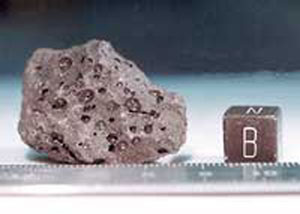Source: NASA
10-19-2007 11:45
 |
A basalt rock that astronauts brought to Earth from the moon formed from lava that erupted from a lunar volcano. Escaping gases created the holes before the lava solidified into rock. Image credit: Lunar and Planetary Institute.
Scientists believe that the moon formed as a result of a collision known as the Giant Impact or the "Big Whack." According to this idea, Earth collided with a planet-sized object 4.6 billion years ago. As a result of the impact, a cloud of vaporized rock shot off Earth's surface and went into orbit around Earth. The cloud cooled and condensed into a ring of small, solid bodies, which then gathered together, forming the moon.
The rapid joining together of the small bodies released much energy as heat. Consequently, the moon melted, creating an "ocean" of magma (melted rock).
The magma ocean slowly cooled and solidified. As it cooled, dense, iron-rich materials sank deep into the moon. Those materials also cooled and solidified, forming the mantle, the layer of rock beneath the crust.
As the crust formed, asteroids bombarded it heavily, shattering and churning it. The largest impacts may have stripped off the entire crust. Some collisions were so powerful that they almost split the moon into pieces. One such collision created the South Pole-Aitken Basin, one of the largest known impact craters in the solar system.
About 4 billion to 3 billion years ago, melting occurred in the mantle, probably caused by radioactive elements deep in the moon's interior. The resulting magma erupted as dark, iron-rich lava, partly flooding the heavily cratered surface. The lava cooled and solidified into rocks known as basalts (buh SAWLTS).
Small eruptions may have continued until as recently as 1 billion years ago. Since that time, only an occasional impact by an asteroid or comet has modified the surface. Because the moon has no atmosphere to burn up meteoroids, the bombardment continues to this day. However, it has become much less intense.
Impacts of large objects can create craters. Impacts of micrometeoroids (tiny meteoroids) grind the surface rocks into a fine, dusty powder known as the regolith (REHG uh lihth). Regolith overlies all the bedrock on the moon. Because regolith forms as a result of exposure to space, the longer a rock is exposed, the thicker the regolith that forms on it.
Editor:Yang Jie
